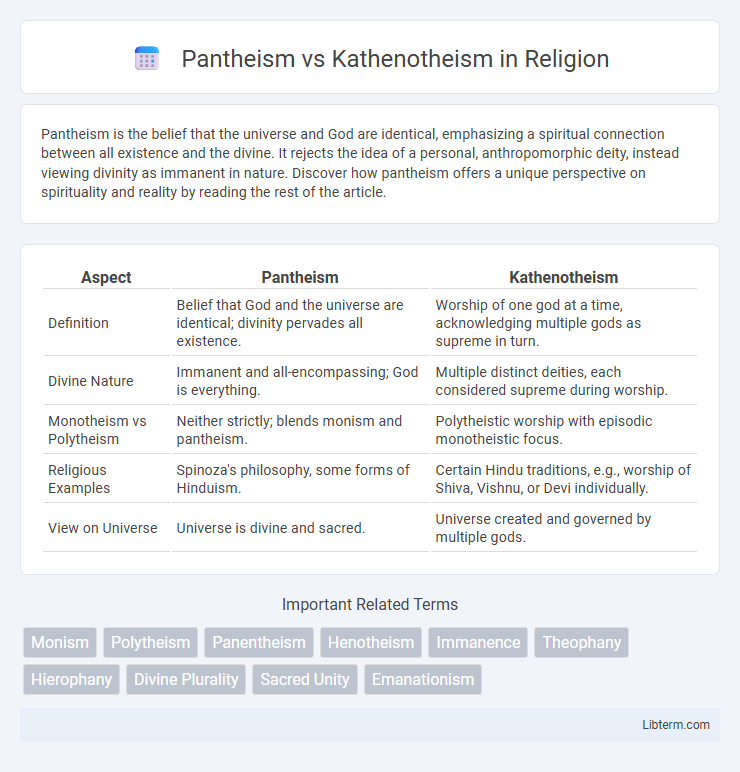Pantheism is the belief that the universe and God are identical, emphasizing a spiritual connection between all existence and the divine. It rejects the idea of a personal, anthropomorphic deity, instead viewing divinity as immanent in nature. Discover how pantheism offers a unique perspective on spirituality and reality by reading the rest of the article.
Table of Comparison
| Aspect | Pantheism | Kathenotheism |
|---|---|---|
| Definition | Belief that God and the universe are identical; divinity pervades all existence. | Worship of one god at a time, acknowledging multiple gods as supreme in turn. |
| Divine Nature | Immanent and all-encompassing; God is everything. | Multiple distinct deities, each considered supreme during worship. |
| Monotheism vs Polytheism | Neither strictly; blends monism and pantheism. | Polytheistic worship with episodic monotheistic focus. |
| Religious Examples | Spinoza's philosophy, some forms of Hinduism. | Certain Hindu traditions, e.g., worship of Shiva, Vishnu, or Devi individually. |
| View on Universe | Universe is divine and sacred. | Universe created and governed by multiple gods. |
Introduction to Pantheism and Kathenotheism
Pantheism identifies the divine with the universe, asserting that God and nature are indistinguishable and all-encompassing. Kathenotheism involves the worship of one god at a time, acknowledging multiple deities as supreme in different contexts or rituals. Both concepts explore the nature of divinity but differ in the approach to the singularity or multiplicity of gods.
Defining Pantheism: Core Concepts
Pantheism defines the universe and God as identical, emphasizing the belief that everything collectively forms a divine whole without distinction between creator and creation. Core concepts include the unity of all existence, where divinity pervades all matter and energy, rejecting the idea of a personal, anthropomorphic deity. This worldview contrasts with kathenotheism, which centers on worshiping one deity at a time while acknowledging the existence of multiple gods.
Kathenotheism Explained: Unique Features
Kathenotheism is characterized by the worship of one god at a time while acknowledging the existence of multiple deities, distinguishing it from pantheism, which sees divinity in everything. This unique approach allows practitioners to focus devotion sequentially on different gods without denying others' reality or power. Kathenotheism is often found in Hindu traditions, where each god is temporarily supreme during individual worship or rituals.
Historical Origins and Development
Pantheism, originating in ancient Greek philosophy with figures like Heraclitus and Stoics, identifies the divine with the universe itself, emphasizing an all-encompassing spiritual presence throughout nature and reality. Kathenotheism, a term coined by Max Muller in the 19th century, arises from Vedic traditions in ancient India, highlighting the worship of one god at a time while acknowledging the existence of multiple deities. Both belief systems evolved through distinct cultural and religious contexts, with pantheism influencing Western metaphysics and kathenotheism shaping Hindu devotional practices.
Key Philosophical Differences
Pantheism asserts that the divine is identical to the universe and everything within it, emphasizing an all-encompassing, singular reality where God and nature are one. Kathenotheism, in contrast, involves the worship of one god at a time among many gods, recognizing multiple deities but focusing on individual divine beings sequentially rather than simultaneously. The key philosophical difference lies in pantheism's monistic view of divinity as an absolute unity versus kathenotheism's pluralistic approach that accepts multiple gods while prioritizing one deity temporarily.
Influences on Religious Practices
Pantheism influences religious practices by promoting the belief that divinity permeates every aspect of the universe, leading to nature worship and rituals emphasizing unity with the cosmos. Kathenotheism, which involves the worship of one god at a time without denying others, shapes practices through sequential devotion and diverse ceremonies dedicated to different deities. These theological frameworks impact the structure, focus, and diversity of worship methods across various spiritual traditions.
Comparative Analysis: God and Divinity
Pantheism identifies God with the universe, positing that divinity is immanent in all things and that the cosmos itself is a manifestation of the divine. Kathenotheism centers on the worship of one god at a time, recognizing each as supreme in different contexts, without denying the existence of other gods, thus emphasizing a sequential supremacy rather than universal immanence. The key difference lies in pantheism's assertion of a singular, all-encompassing divine reality versus kathenotheism's flexible, situational elevation of multiple deities.
Modern Interpretations and Trends
Modern interpretations of Pantheism emphasize a unified divine presence within all aspects of the cosmos, often aligning with ecological and scientific perspectives that highlight interconnectedness and holistic spirituality. Kathenotheism in contemporary discourse is explored through its acknowledgment of multiple deities worshipped one at a time, reflecting pluralistic spiritual practices and personalized religious experiences prevalent in new religious movements. Current trends show Pantheism gaining traction among environmentalists and secular spiritual seekers, while Kathenotheism appeals to those embracing syncretism and the flexibility of honoring varied divine manifestations sequentially.
Critiques and Controversies
Pantheism faces critiques for its perceived reduction of God to the universe, challenging traditional theistic views of a personal deity and raising debates about the nature of divinity and spirituality. Kathenotheism, characterized by the worship of one god at a time without denying the existence of others, encounters controversy regarding its theological consistency and the interpretation of polytheistic practices in monotheistic frameworks. Both perspectives provoke scholarly discussion on the boundaries between monotheism, polytheism, and panentheism, highlighting tensions in religious identity and doctrinal exclusivity.
Conclusion: Understanding Divinity in Diverse Belief Systems
Pantheism identifies divinity with the universe, asserting that everything collectively embodies the divine, which promotes an all-encompassing view of sacredness. Kathenotheism centers on the worship of one god at a time while acknowledging the existence and reverence of multiple deities, reflecting a flexible and dynamic approach to divine presence. Both belief systems enrich theological discourse by highlighting diverse perceptions of divinity, emphasizing unity in pantheism and individuality in kathenotheism.
Pantheism Infographic

 libterm.com
libterm.com